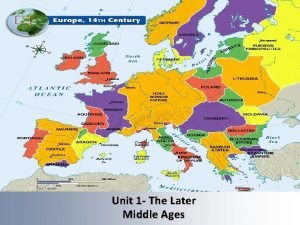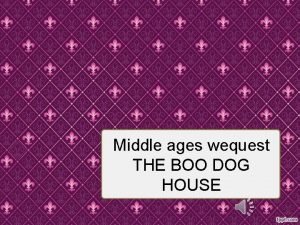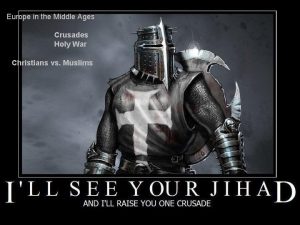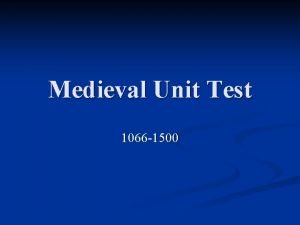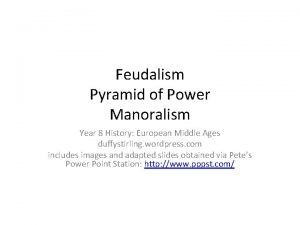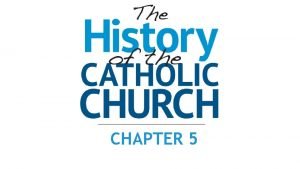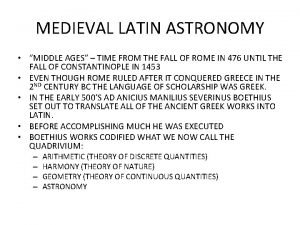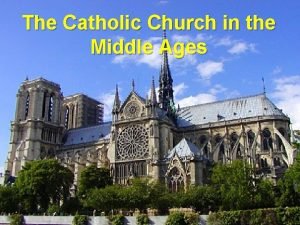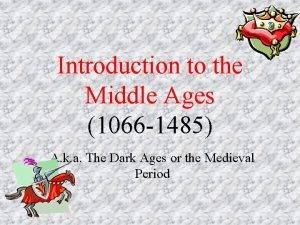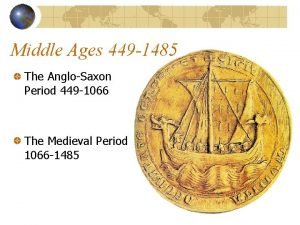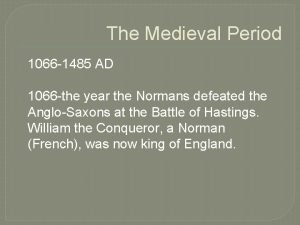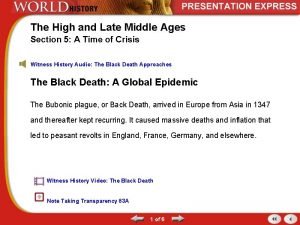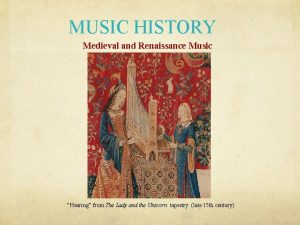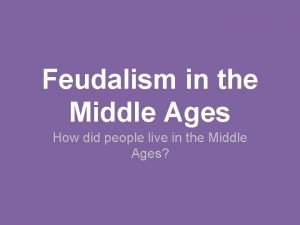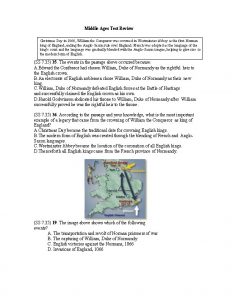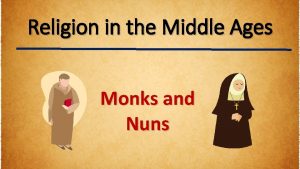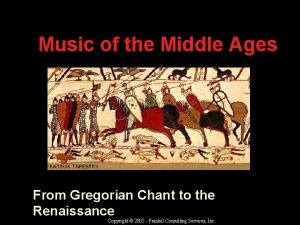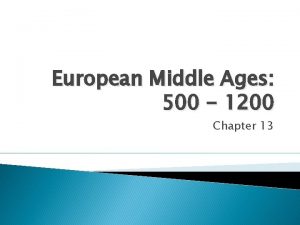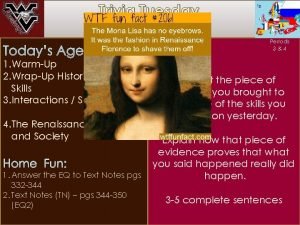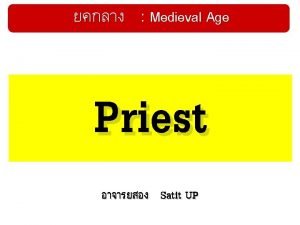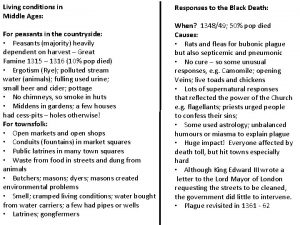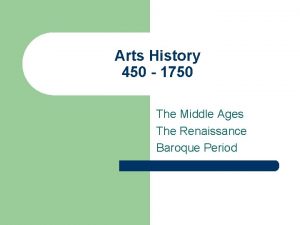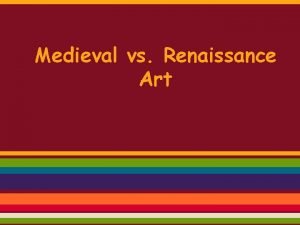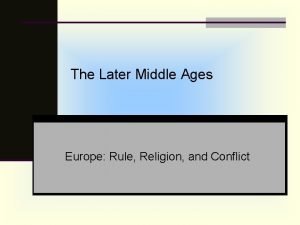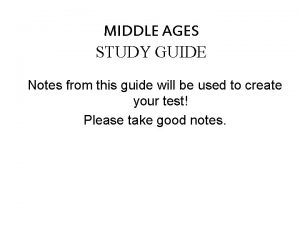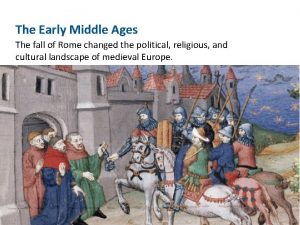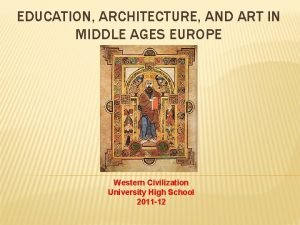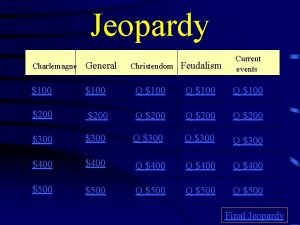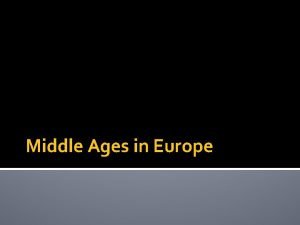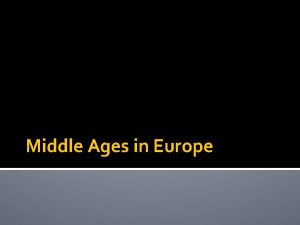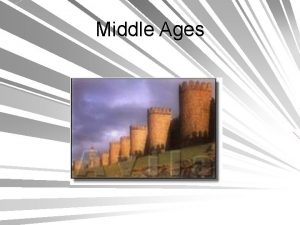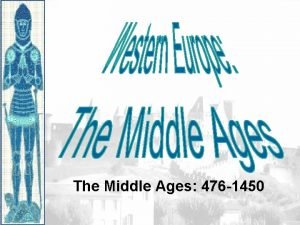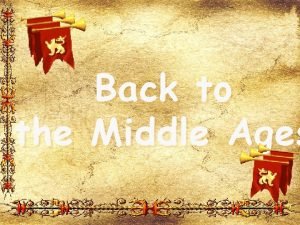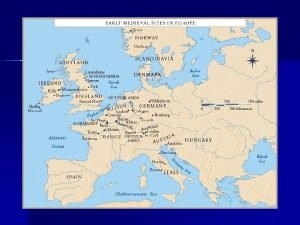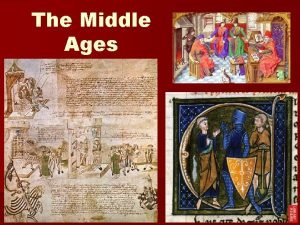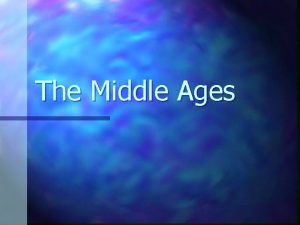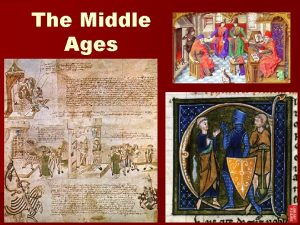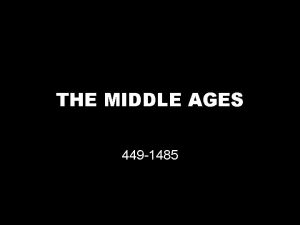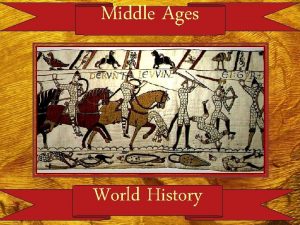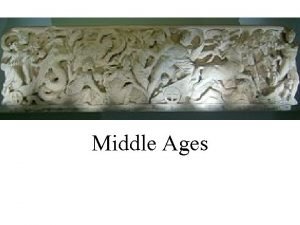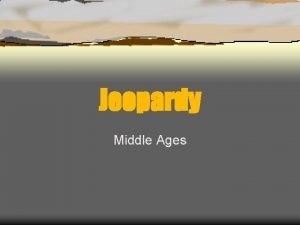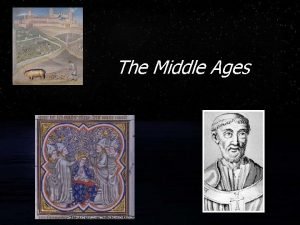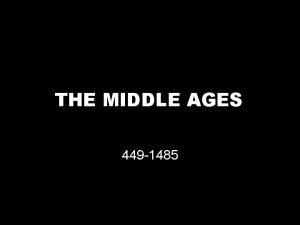The Middle Ages in Europe 476 A D




































- Slides: 36

The Middle Ages in Europe (476 A. D. – 1400’s) Chapter 8

1) 2) 3) 4) 5) Page 1: Essential Questions What were the main characteristics of the Byzantine Empire? (Pages 2, 4) How was Western Europe affected by the collapse of Rome? (Page 6) How did the system of feudalism restore order to Western Europe? (Pages 8, 10) How did religious beliefs shape life-styles in this period? (Page 12) How did English political traditions contribute to our American system of government? (Page 14)

Page 3: Key Terminology 1) 2) 3) 4) 5) 6) 7) 8) Byzantine Empire 9) Knights 17) Thomas Aquinas Constantinople 10) Serfs 18) Magna Carta Eastern Orthodoxy 11) Manor Code of Justinian 12) Manorialism Middle Ages 13) 3 -Field System Charlemagne 14) Roman Catholicism Feudalism 15) The Pope Lords 16) Crusades

Page 2: Introduction • Byzantine Empire merged with Constantinople, lasting 1 K years—Emperor Justinian used Roman laws to create new legal code • After fall of Roman Empire, Europe fell into period of chaos know as the Dark Ages—invaders kept cities in chaos—cities became ruined and weak—the learning of the ancient world was lost • As a result, Europeans developed feudalism—the Catholic church preserved learning & became most power institution in Europe

Introduction: (continuation) • St. Augustine emphasized the role of faith • St. Thomas Aquinas believed Christian teachings were compatible with the exercise of reason • Christians and Muslims fought for the Holy Land—The Crusades

Page 2: A Byzantine Culture Emerges • 330 A. D. Emperor Constantine moved the empire’s capital to Byzantium, renamed it Constantinople • Constantinople was surrounded by 3 sides of water and had thick walls—almost impossible to attack • Western half of Roman Empire collapsed in 400 A. D. – Eastern half survived another 1 K yrs. • Imperial system of govt. /led by an emperor

• Official language was Latin but was changed to Greek • Did not follow Roman Catholicism, they were Eastern Orthodox Christian • Eastern Orthodox: does recognize Pope as head of church, had own patriarch/leader, decorated churches with icons/images of Jesus and saints

Byzantines Develop a Strong Culture • Church of Hagia Sophia • Schools taught ancient Greek texts • Used gold, silver, and ivory for art/expensive materials! • Known for exquisite art and elongated tile mosiacs

Under Emperor Justinian (527 -565 A. D. ) • Conquered the old Roman Empire • Justinian’s Code: organized Roman laws into a single code/text • Special religious laws, all people had to be E. Orthodox

Page 4: Reasons 4 survival of Byzantine Empire • Classical Culture: rich infusion of Greek, Roman, Christian, and Middle Eastern cultures • Location: major city 4 trade: silks and spices from East, furs from Russia • Strong Central Govt. : powerful emperors with strong administrators and single set of laws • Large Army: taxed merchants and peasants to support army

Decline of Byzantine Empire • In constant battle with: Slavs and Avars to the north, Persians to the east, Islam/Muslims to the south, Muslims took most of lands in the Middle East • Seljuk Turks defeated Byzantine army in 1071 • Crusaders attacked city in 1204 • By 1440’s empire reduced to small area around Constantinople • 1453 Constantinople conquered by Ottoman Turks

Western Europe in Turmoil • The Barbarian Invasions: Romans considered foreigners “barbarians”, Germanic tribes: Goths, Vandals, Lombards, Burgundians, and Franks • In 300 A. D. warlike tribe-Huns attack Roman Empire • Visigoths sack Rome in 410

Germanic Tribes Created Kingdoms • Angles and Saxons/England • Visigoths/Spain • Lombards/N. Italy • Franks/Gauls take France

Page 5: Byzantine Empire Influences • Read page 106: Influence on Russia segment • Write 1 -2 short paragraphs summarizing how the Byzantine Empire influenced Russia’s economy, politics/government, culture, and religion. • Be sure to address all components of this assignment!

Page 6: Constant Warfare Creates Chaos (Leads to Feudalism) • Traveling became unsafe • Bridges/roads fell apart • Cities/towns abandoned • Criminals roamed free • Rich families moved to fortified homes/castles in countryside • Food shortages

The Rise of the Franks • Franks estab. largest Germanic kingdom • Charles Martel unites Franks • (732 A. D. ) Battle of Tours - Martel stops advance of Islam from Spain into France • (751 A. D. ) Martel’s son, Pepin- seized power and now King of Franks • Frankish kings created powerful army by granting land to nobles in exchange of service in King’s army with their knights = Feudal System

Reign of Charlemagne • Pepin’s son, Charlemagne, became king in 768 • Expanded practice of giving land to nobles in exchange for loyalty and services • Nobles gave land to knights in exchange for protection • Peasants gave up their rights to their local lords for protection • Services included providing firewood, livestock, crops

• Charlemagne’s kingdom included: France, Germany, Holland, Belgium, N. Italy • Used $$ 2 attract scholars to his palace 4 children of nobility • Crowned “Emperor of the Holy Roman Empire” • After his death, the empire was divided among his sons

Page 8: Europe’s New Threats • Slavs and Magyars from east invaded Germany, France, Italy • Muslims from N. Africa attack S. Italy • 800 -1000 A. D. Vikings- fierce warriors from north/Scandinavia attacked coasts of W. Euro. (England & France) • Spread fear and destruction

Page 7: Feudalism Social Structure • Use notes found on pages 8 and 10 in ISN • Create a graphic organizer/chart featuring the social system of Feudalism • Be sure to incorporate into your graphic organizer the relationships between following people and terms : lords, nobles, knights, serfs, fief, manor, • You may wish to examine pages 110 -111 in textbook

Feudal Society • In order to protect themselves and provide basic needs, people adopted feudalism • King would give land (fief) to noble (vassal) in exchange for loyalty and service • Vassal would give piece of land to servants in exchange for services and food

Feudalism: Social • Strict class structure based on control of land military power • People born as serf/peasant farmers, knight, or lords could not change social positions • Lords who had large pieces of land had a large army of knights

Feudalism: Political • Leading nobles controlled political life • Built large castles for protection • King needed lord’s knights for his army • Nobles fought against each other and against king • Civil wars were frequent and powerful nobles would take land

Page 9: Feudalism • Summarize: How did the system of Fedualism restore order to Western Europe after the Fall of the Roman Empire? • Length: 1 -2 paragraphs

Page 10: Feudalism: Economic • Most people lived in manors • Each manor produced its own food, clothing, shelter • In England alone, 9 K manors alone • Serfs gave their lord a part of their harvest, in return they would get land to live on and protection • Lord passed laws, required labor, acted as judge • Serfs were property, bound to the land their lords • Serfs could almost be considered slaves

Farming in the Middle Ages • Farmers used a 3 -Field system: 2 fields used to farm, 1 for summer, 1 for winter, 1 left to recover fertility/fallow • Farm animals were small and few • Bad weather and poor harvest could lead to famine or death

Peasant Life Styles • Produced the food needed • Worked long hours, most on the land • Most were farmers some had other jobs(millers, blacksmiths, tavern owners) • Lived on farms or near cities on a lord’s manor • Cottage house had no floors, bed was made of hay, pigs and animals lived inside house • Water was drawn from a well or stream

Women in the Middle Ages • Roles were determined by Catholic Church • Suppose to be obedient to men • Gave birth to large # of children/many died in infancy • Life-styles varied according to social status • Noble women spent most time praying and domestic chores (some would receive and education) • Peasant women worked in fields plus take care of house, husband, children and animals

Page 12: The Age of Faith • Catholic Church single most powerful organization in W. Europe • Pope: head of the church, governed cardinals, bishops, and other important church officials • Church controlled large amounts of land in Euro. • Possessed monasteries, abbeys, convents

Page 11: Two Christian Thinkers • Read pages 112 -113 in textbook • Why do you think the teachings of Saint Augustine and Saint Thomas Aquinas were important to people in the Middle East? • Length: 2 paragraphs: one paragraph addressing each saint

Reasons for the Church’s Power • The Role of Faith: people very religious, church represented God and had power to send people to heaven/hell • Power and Wealth: nobles gave land to church when they died hoping to go to heaven, church largest landowner in Europe, collected $ through tithes/church tax • Center of Learning: church officials usually only people able to read and write, rulers depended on church because they were educated

The Crusades Holy War vs. Muslims • 1000 A. D. Seljuk Turks/Muslims took control of the Holy Land (Jerusalem), drove out the Christians • 1095 Pope Urban II received plea from Byzantine Emperor with the Muslim invasion • Church called all Christians to Europe to unite and recapture the Holy Land • Volunteers were promised salvation

• “Crusade”- means “war of the cross” • Flag was a red cross with a white banner • Many participants died of hunger or disease on way 2 Holy Land • Several crusades were fought for next 200 years

Page 13: The Crusades • Using ISN notes on page 12 and textbook page 115 • Create a recruitment poster featuring Pope Urban II call for the Crusades • Poster should include relevant images, wording, and color

Page 14: English Political Traditions • England developed traditions of liberty and limited selfgovernment • 1215 Magna Carta • English Bill of Rights

Page 14: 1215 Magna Carta • King John II forced to sign agreement by nobles • Couldn’t take away a free man’s property • Couldn’t imprison a man w/out legal procedures • Free men had right to trial by jury • King needed consent of council of nobles for new taxes • Significance: helped establish Parliament, King must now consult other branches of government, does not have unlimited power
 Dark ages vs middle ages
Dark ages vs middle ages Renaissance art vs medieval art
Renaissance art vs medieval art Art of emerging europe example
Art of emerging europe example European middle ages map
European middle ages map During the middle ages noblewomen had
During the middle ages noblewomen had Middle ages
Middle ages Sacred music of the middle ages
Sacred music of the middle ages Middle ages unit test answers
Middle ages unit test answers Late middle ages timeline
Late middle ages timeline Feudal pyramid
Feudal pyramid Similarities between middle ages and renaissance
Similarities between middle ages and renaissance Astronomy in the middle ages
Astronomy in the middle ages Middle ages
Middle ages The middle ages 1066 to 1485 unit test closed book
The middle ages 1066 to 1485 unit test closed book A metaphorical phrase used to replace a concrete noun
A metaphorical phrase used to replace a concrete noun Middle ages
Middle ages The middle ages 1066-1485 unit test
The middle ages 1066-1485 unit test The high and late middle ages section 5 quiz
The high and late middle ages section 5 quiz The middle ages spans nearly one thousand years.
The middle ages spans nearly one thousand years. Feudal system in the middle ages
Feudal system in the middle ages Middle ages test review
Middle ages test review Medieval vs renaissance
Medieval vs renaissance Monks and nuns in the middle ages
Monks and nuns in the middle ages Gregorian chant middle ages
Gregorian chant middle ages Medieval hierarchy
Medieval hierarchy Middle ages def
Middle ages def Middle ages renaissance
Middle ages renaissance Roman catholic church hierarchy pyramid
Roman catholic church hierarchy pyramid Living conditions in the middle ages
Living conditions in the middle ages 450/1750
450/1750 Middle ages
Middle ages Early middle ages
Early middle ages Middle ages study guide answer key
Middle ages study guide answer key Early middle ages
Early middle ages Colonial williamsburg floral design history
Colonial williamsburg floral design history Cathedral art
Cathedral art Current events jeopardy
Current events jeopardy



